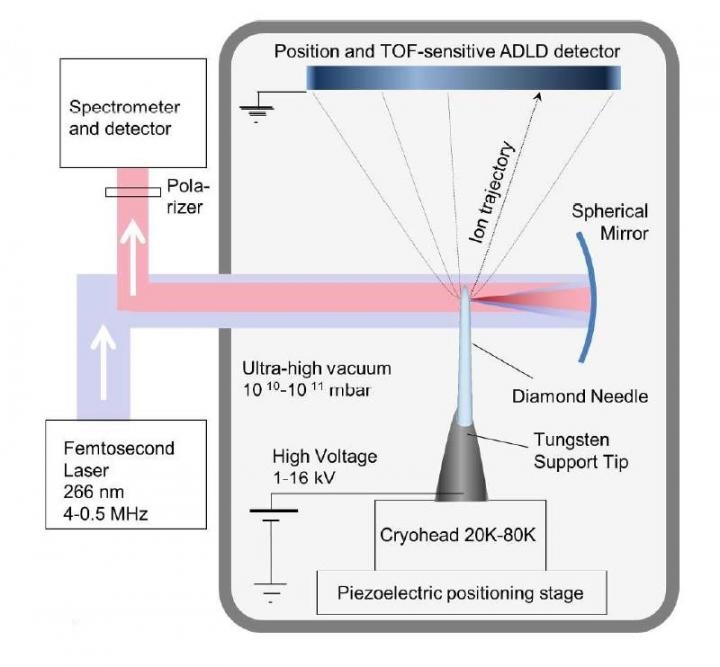Dec 7 2017
A team of researchers from the Lomonosov Moscow State University’s Faculty of Physics discovered a stretching of acicular diamond crystallites under an electric field action.
The deformation that occurs during the stretching makes changes in luminescence spectrum. This result can be used for the development of electric field detectors and other quantum optic devices. The research finding was published in the magazine Nano Letters.
 This is the scheme of the experiment (for practical use). Credit: Alexander Obraztsov
This is the scheme of the experiment (for practical use). Credit: Alexander Obraztsov
Diamonds are minerals made up of carbon and commonly known by their phenomenal hardness. In addition, diamonds have other excellent features. However, they always contain structural defects similar to other crystals. Some of them make changes in luminescence or coloring (light absorption) and are called color centers. Particular characteristics of some kinds of the color centers in diamonds make them appropriate for use in quantum optic devices such as qubits that are dependent on entanglement of the photons quantum states. For using a diamond in such devices, the distance between its individual color centers must be about 30 nm.
A team of researchers led by Alexander Obraztsov, professor of the Department of Polymer and Crystal Physics of the Faculty of Physics, MSU has discovered a method for mass production of diamond micro-needles in its earlier studies. At first, this method includes growth of diamond crystallites as fraction of the films (also containing other non-diamond fractions) produced by chemical vapor deposition of hydrogen and methane mixture. All spare materials are then removed (by burning) from the films using their heating in the air.
In this new work we tried to learn as much as possible about diamond needles that we produce, specifically about their color centers.
Alexander Obraztsov, Professor of the Department of Polymer and Crystal Physics, The Faculty of Physics, MSU
Russian researchers turned to their French colleagues that employ a unique methodology for the required analysis in order to understand the position of color centers in the structure of the samples and to detect their properties. "Our French colleagues apply it to study chemical composition and location of impurities in different materials," explained Obraztsov.
During the measurements, diamond needles were fixed to an electrode positioned on a high vacuum chamber. In order to attain the stretching effect, high voltage was used to the electrode producing electrical polarization of the dielectric diamond, as well as substantial mechanical stress stretching the needle. The stretching caused deformation in the crystal structure of diamond.
The authors said that this also causes changes in individual color centers, and their quantum optic properties changed together with the structure. Earlier, researchers were only able to compress diamonds, and this is the first time that a diamond has been stretched.
During stretching, the sample was irradiated with a laser and luminescence of the color centers was recorded with a spectrometer. The experiment revealed changes of shape and energy of luminescence bands based on the stretching force set by the applied voltage. According to the team, the similar diamond needles could be employed to develop high spatial resolution detectors for contact-free measuring of electric fields.
Detectors like this could be used not only to measure the fields created by high voltage in high vacuum, but those existing in biological molecules (DNA, RNA, etc.). Measurement of such fields is a burning scientific issue today.
Alexander Obraztsov
The diamond needles at their apex measure several to several hundred nanometers in dimensions. Therefore, according to the researchers, it is possible to make measurements with precision that corresponds to particular molecule fragments.
Diamond micro-needles made through this method, developed by the MSU team, could also secure contact-free optical detection of magnetic fields, temperature, as well as other characteristics with micro- and nanoscopic spatial resolution.